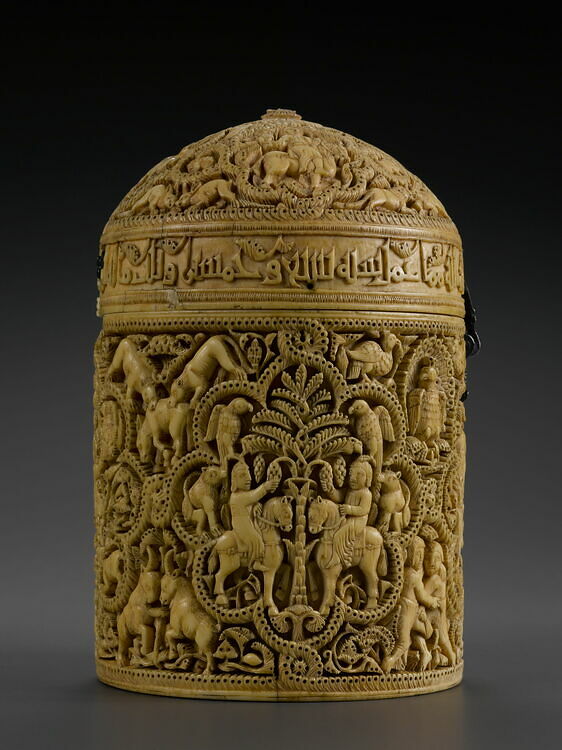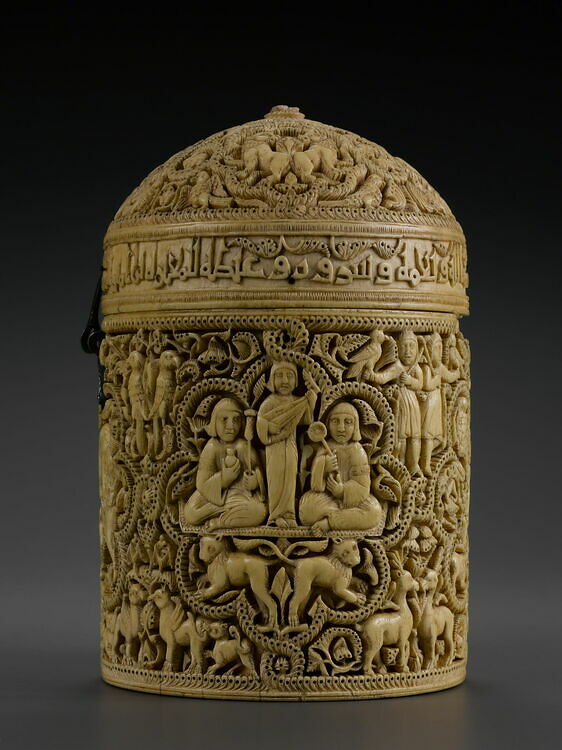Ivory Pyxis, Umayyad Spain, 968
|
A detail of the two horsemen on the Ivory Pyxis with the name of Al-Mughira, Umayyad Spain |
| A detail of the wrestlers. |

A larger detail of the men bitten by animals on the Ivory Pyxis with the name of Al-Mughira, Umayyad Spain

A detail of the three figures on the Ivory Pyxis with the name of Al-Mughira, Umayyad Spain

A larger image of the lions on the Ivory Pyxis with the name of Al-Mughira, Umayyad Spain
Pictures Source: Louvre Museum, Department of Islamic Art, OA 4068.

Picture Source: Louvre Museum, Department of Islamic Art, OA 4068.
Title/name : Pyxis of al-Mughira
Author : Madinat al-Zahra?, Spain
Date / period : AH 357/AD 968
Materials and techniques : Carved ivory with traces of jet
Conservation town : Paris
Conservation place : Musée du Louvre, Islamic Art Department
Inventory number : OA 4068
Inscription : Around the base of the lid, in kufic script: ‘God's blessing, favours, joy, beatitude to al-Mughira son of the Commander of the faithful, may God have mercy upon him, in the year 357.’
This ivory casket with a convex lid and cylindrical body is remarkable for the finesse and depth of its carving—it is one of the masterpieces of the Madinat al-Zahra workshops, produced during the period of the Caliphate of Córdoba. The inscription around the base of its lid mentions the date 968. In that year, al-Mughira, the last son of the dead caliph ‘Abd al-Rah.ma-n III, was eighteen years old. This work may have been a coming-of-age present[1].
The pyxis is decorated with four polylobed medallions, ornamented with princely iconography, which are surrounded by various sets of people and animals. One of the medallions contains two lions attacking two bulls—a symbol of victory that was associated with the sun of the spring equinox in Achaeminid Persia. The opposite medallion shows two people collecting eggs from falcon nests, which is probably a reference to the quest for sovereignty: the Umayyads of Spain were known as ‘the falcons of the Quraysh’ and Córdoba was sometimes compared to an egg. The other two medallions contain huntsmen on horseback picking dates from a palm tree (another reference to the East), and two young princes sitting cross-legged either side of a lute player. One is holding a flask and the braided rod of the Umayyads, and the other a disk-shaped fan.
The pyxis may have been an invitation to receive or ‘gather’ power, as its iconography suggests. It was probably the result of an order made by al-Mughira's supporters, who were mainly comprised of the fityan, or palace officers[2].
There are around twenty pieces in ivory—pyxides and caskets with a flat or conical cover—and ten or so fragments of plaques, which date from the period of the Caliphate of Córdoba. They are directly associated with the expression of power and the history of the dynasty. An epigraphic band, on the base of the cover, usually reveals who the object was made for, the date of fabrication, and sometimes the name of the craftsman and workshop. Before 970, these objects were given exclusively to the mother, daughter, or son of the caliph. The name Madinat al-Zahra appears on three of the objects. The name Khalaf also appears—he was an ivory-worker who is credited with the pyxis of Queen Subh, the favourite of the caliph al-Hakam II and Hisham's mother.
What were these cylindrical containers, which were sometimes encrusted with precious stones, used for[3]? They may have been used for jewels, gems, seals, or aromatic substances. A poem written about the pyxis of Subh ends with these words: ‘I'm a container for musk, camphor, and ambergris’[4].
These carved ivory containers, with their rich figurative decorations, can't be viewed in isolation. They are part of a tradition of luxury crafts that has existed in the courts since classical antiquity. Examples include the extraordinary Byzantine plaques (the Barberini ivory) produced in the fifth and sixth centuries, diptychs, and Carolingian and Ottonian objects. The Córdoba pyxides, which have Sassanid elements—candelabra trees, palm-shaped half leaves, and antithetical animals—had Muslim equivalents in the East, as shown by the piece discovered in Jordan.
In the Latin West, they often served as reliquaries, because they were miniature reproductions of circular sanctuaries, and they all influenced each other, depending on their respective sizes. In the twelfth century, they became part of the iconography of the Magi, and were used as containers for myrrh and incense.
NOTES
[1] In 968, the reigning caliph, al-Hakam II, the eldest son of the prince, was already old and ill and his four-year-old son, Hisham, was too young to succeed him. Only al-Mughira was old enough and had the necessary qualities to be his successor. When al-Hakam II died seven years later, in 976, it was Hisham, then eleven years old, who was appointed caliph. This resulted from intervention by Subh and her favourite, the vizier Ibn Abi- Ami-r al-Mansu-r (who eventually seized power). Al-Mughira and his supporters were killed.
[2] These included: Durri- al-Saghi-r, who was in charge of the manufacture of ivory objects, Jawdar, goldsmith and falconer to al-Hakam II, and Fa’iq, director of the tiraz (large factory complexes). They were all killed or disgraced after the accession of Hisham to the caliphate and the execution of al-Mughira.
[3] Traces of jet were found in some alveoli of the pyxis of al-Mughira.
[4] Pyxis kept in the Hispanic Society of America, New York.
Text source: Qantara
academia.edu
Enclosed in Ivory: The Miseducation of al-Mughiramore
by Francisco Prado-Vilar
See also:
Horsemen on an Umayyad Casket from Cordoba, c.966-968
Ivory Pyxis of Ziyad ibn Aflah, Umayyad Spain, c. 969-970
The Valcavado Beatus Codex by Beatus of Liébana, Spain, 970
Ivory Pyxis from Madinat al-Zahra, Umayyad Spain, 970AD
Other 10th century Illustrations of Costume & Soldiers
Other Spanish and North African Illustrations of Costume & Soldiers
